Cherry Head Tortoises also named Eastern, Brazilian or Bolivian red-footed is a territorial color mutation of cherry head red-footed tortoise. They have very strong senses to know things. These are native to the Amazon region of Southern America, the Caribbean, and Brazil. Cherry heads vary from red-footed in a wide range from size to shell shapes and plastron patterns. All cherry head species are determined by a Latin name Geochelone carbonaria.
- Related: What do Snapping Turtles Eat
Cherry head tortoise size
Cherry head tortoises are medium-sized and mostly grow about 10 to 14 inches in length and often reach up to 15 inches at full maturity. Giant cherry head tortoise subspecies are generally about 16 inches. With the early 5 to 10 years of their life, they begin to grow faster but the rate of their growth slows when they start to become old.
Cherry head tortoise weight
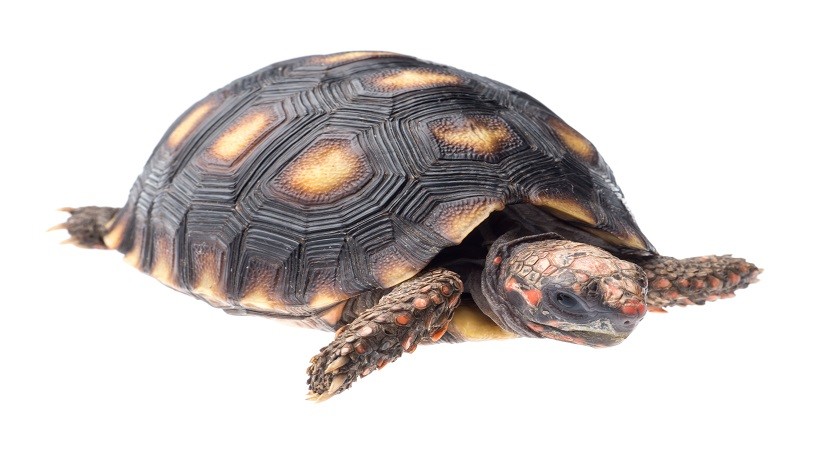
They are bulky and usually weigh about 5kgs approximately 11lbs smaller than their cherry head red-footed tortoise and yellow-footed cherry head tortoise cousins.
- Related: What do Baby Turtles Eat
Cherry head tortoise lifespan
They are generally long-lived tropical species having a life span above then 50+ years to an average of 90 years in captivity under proper care.
- Related: What do Painted Turtles Eat
Cherry head tortoise care
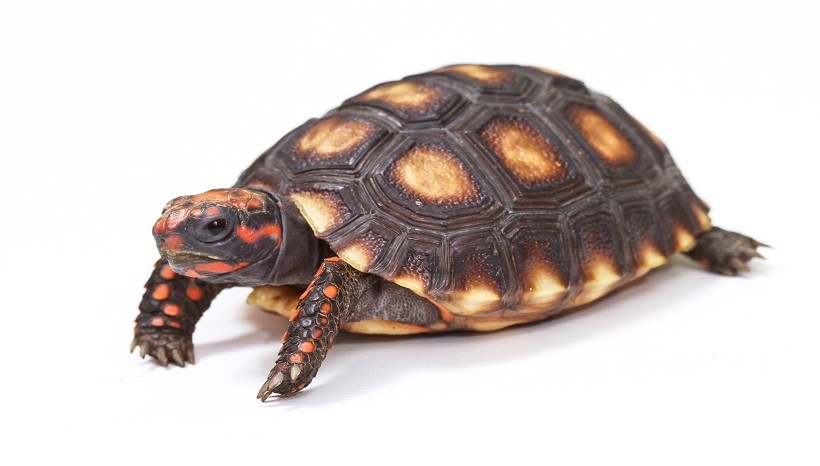
Cherry head tortoise care is quite different from other forest’s tropical tortoise subspecies. Proper care needs a high-quality diet with other sufficient parameters like heated and large habitat, temperature gradients, higher humidity, soaking schedule, etc.
Never feed them on icebergs and round lettuce because of its high water content. Rinse the food and water dishes daily and clean their vivarium weekly to remove poops. Never give them cold tap water as it may cause a dilemma to them.
It is recommended to soak your baby tortoise for 10-15 minutes every morning in a warm water dish as it makes him feel good. Avoid over-handling the tortoise as it may lead to stress-causing death oftentimes.
Cherry head tortoise habitat
- Cherry head tortoises mostly survive in tropical circumstances. They are available in the rivers and near the sides of tropical forests.
- They should be kept in a warm habitat under a temperature of 95F and maximum cool around 82F to 85F during summer and drop it from 10F-15F at night.
- Prefer to place them in a suspicious habitat minimum of 36″x 18″ that would not be able to change before the 2 years.
- Meanwhile, on the warm days of summer, a newly developed baby cherry head tortoise can keep outside. Just remember to bring them inside at night. Placing babies in aquariums is also common.
- Give each adult cherry head tortoise a larger area of 6’x3′ to roam and exercise freely and give them both indoor and outdoor habitat.
Cherry head tortoise humidity
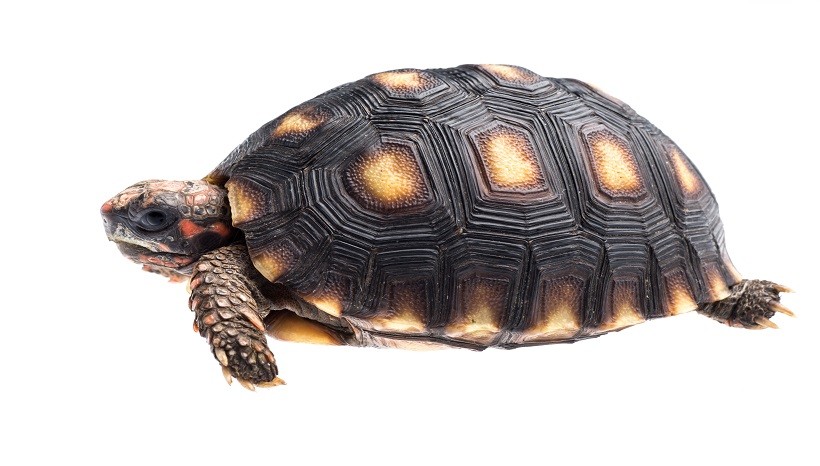
Cherry head tortoise is a high humid species. They need higher humidity as related to other tortoise species. Moreover, other cherry head species also possess the same higher humidity requirements.
It is strictly recommended to provide them with an average of 75% humidity to grow successfully throughout their whole lifespan. To maintain complete humidity and hydration in the habitat, prefer to utilize a reptile fogger, room humidifier, reptile misting system for new baby tortoise.
Cypress bark is a substrate that is place in the indoor habitat of the tortoise to maintain humidity in a natural way. Use a hygrometer to measure the humidity level of the vivarium.
Cherry head tortoise for sale
Cherry head tortoises and their young hatchlings are available for sale online at different pet websites and best breeders. Their price usually begins from about $375.00 – $1,299.00. They are available in excellent quality and a wide range of sizes online.
Cherry head red foot tortoise
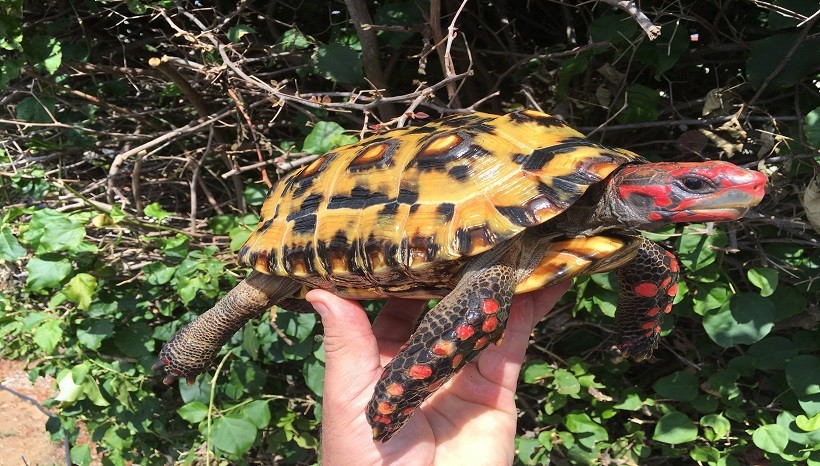
Cherry head red foot tortoise is a small-sized variation of the red-footed tortoise family with a distinct appearance. They are much similar to the yellow-footed tortoise. Their heads and limbs contain from red or yellowish color to excellent cherry heads. They are good pets exhibiting fairly shy and friendly temperaments.
Cherry head red foot tortoise size
Cherry headed red foot tortoise’s size grows mainly up to 14 inches in length. Their average adulthood size often reaches 11 inches.
Cherry head red foot tortoise care
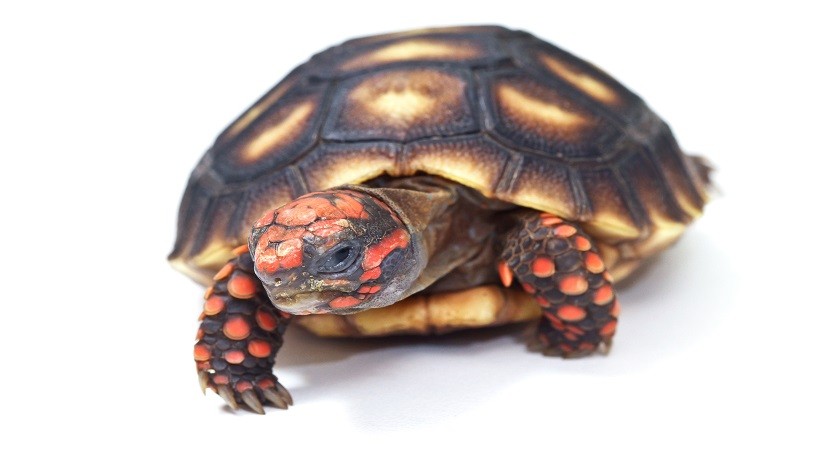
Cherry head red-footed tortoises are the simplest to care for and have similar care requirements likewise their other cousin species.
- Give them warm, filtered, and freshwater for drinking and wading purposes.
- Also, provide them with warm water in a separate dish that is large enough for the tortoise to soak themselves.
- Maintain the vivarium with required temperatures and humidity levels.
- Spot the poops and clean their habitat thoroughly on a weekly basis.
- Also, cleanse their water and food dishes regularly or after every two days.
- Provide them with a high-quality balanced diet.
- Keep the baby red-footed tortoise hydrated and humid by spraying water on their habitat walls from inside and outside.
Cherry head red-foot tortoise for sale
Cherry head red-foot turtles are low price tortoises. Their price range starts from $150 to $500. You can avail Cherry head red-footed tortoise for sale online easily from experts cherry head red-foot breeders that raises a fine and colored variety of this species.
Cherry head tortoise vs red foot
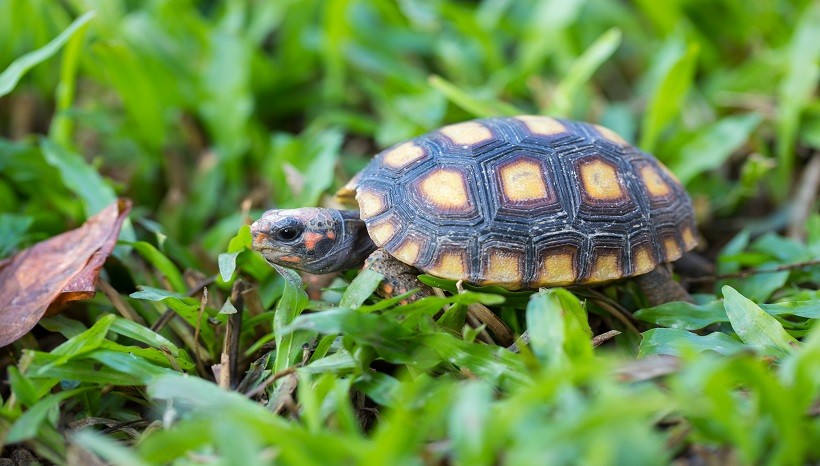
Cherry head and red foot tortoise are a bit different from each other.
- The cherry head is a regional color variation of red-foot.
- Cherry heads are available in South Amazon while red-foots are the species that belong to North Amazon.
- They vary in a wide range of sizes, some are smaller others are big.
- They differ from each other in their shell shapes.
- Their plastron patterns also alternate from one another.
- They also vary a little from each other in terms of habitat temperature and humidity level.
- The price range of cherry head red-footed tortoise is low as compared to regular cherry heads.
Conclusion
Cherry head tortoises are not intentionally bred. They are available naturally in the wild areas and prefer to survive in a humid climate. They are good pets not allow to handle exclusively as this can cause illness.
On the other hand, cherry head red-footed tortoises abide as omnivores eating a broad variety of food. Their feeding time mostly depends upon their size as well as on age. They are intelligent in locating their food.
FAQs
1. What kind of wood chips for the cherry head tortoise?
Cypress mulch is use as an effective wood chip substrate for cherry head tortoises. It helps to maintain humidity naturally in an enclosure.
2. How to know if your cherry head tortoise is not healthy?
Showing bright and clear eyes with no discharge or swollen eyelids is a sign that your cherry head tortoise lacks any illness. They also show a growth ring at the top of their lower marginal scutes and feel harder during holding. Taking a healthy diet, solid shells, and normal poops show that your tortoise is healthy and fit.
3. How to take care of a cherry head red foot tortoise?
Soak your cherry head red-footed tortoise in warm water once a day. Avoid giving them cold tap water to drink. Provide them with a balanced diet in accordance with their size and age. Moreover, try to keep their enclosure humid and hydrated throughout the year.
4. How old is my cherry head tortoise?
Cherry head tortoises grow quickly. They usually have a longer lifespan of 90+ years when they are properly take care in captivity.
If you want to learn more about pets visit us at petshoods
{ "@context": "https://schema.org", "@type": "BlogPosting", "mainEntityOfPage": { "@type": "WebPage", "@id": "https://petshoods.com/cherry-head-red-footed-tortoise/" }, "headline": "Cherry Head Red Footed Tortoise | Size, Weight, Care, Lifespan, Price", "description": "Cherry head tortoise habitat · Cherry head tortoises mostly survive in tropical circumstances. · They should be kept in a warm habitat under a temperature of 95F and maximum cool around 82F to 85F during summer and drop it from 10F-15F at night.", "image": "https://petshoods.com/wp-content/uploads/2021/04/Cherry-Head-Tortoises.jpg", "author": { "@type": "Person", "name": "jeremy" }, "publisher": { "@type": "Organization", "name": "petshoods", "logo": { "@type": "ImageObject", "url": "https://petshoods.com/wp-content/uploads/2019/02/13925402_1502331219793083_1620090286454245017_n.jpg" } }, "datePublished": "2021-04-29", "dateModified": "2021-07-10" } { "@context": "https://schema.org", "@type": "FAQPage", "mainEntity": [{ "@type": "Question", "name": "What kind of wood chips for the cherry head tortoise?", "acceptedAnswer": { "@type": "Answer", "text": "Cypress mulch is use as an effective wood chip substrate for cherry head tortoises. It helps to maintain humidity naturally in an enclosure." } },{ "@type": "Question", "name": "How to know if your cherry head tortoise is not healthy?", "acceptedAnswer": { "@type": "Answer", "text": "Showing bright and clear eyes with no discharge or swollen eyelids is a sign that your cherry head tortoise lacks any illness. They also show a growth ring at the top of their lower marginal scutes and feel harder during holding. Taking a healthy diet, solid shells, and normal poops show that your tortoise is healthy and fit." } },{ "@type": "Question", "name": "How to take care of a cherry head red foot tortoise?", "acceptedAnswer": { "@type": "Answer", "text": "Soak your cherry head red-footed tortoise in warm water once a day. Avoid giving them cold tap water to drink. Provide them with a balanced diet in accordance with their size and age. Moreover, try to keep their enclosure humid and hydrated throughout the year." } },{ "@type": "Question", "name": "How old is my cherry head tortoise?", "acceptedAnswer": { "@type": "Answer", "text": "Cherry head tortoises grow quickly. They usually have a longer lifespan of 90+ years when they are properly take care in captivity." } }] } { "@context": "https://schema.org/", "@type": "ItemList", "itemListElement": [ { "@type": "ListItem", "position": 1, "name": "Cherry head tortoise size", "url": "https://petshoods.com/cherry-head-red-footed-tortoise/#Cherry_head_tortoise_size" }, { "@type": "ListItem", "position": 2, "name": "Cherry head tortoise weight", "url": "https://petshoods.com/cherry-head-red-footed-tortoise/#Cherry_head_tortoise_weight" }, { "@type": "ListItem", "position": 3, "name": "Cherry head tortoise lifespan", "url": "https://petshoods.com/cherry-head-red-footed-tortoise/#Cherry_head_tortoise_lifespan" }, { "@type": "ListItem", "position": 4, "name": "Cherry head tortoise care", "url": "https://petshoods.com/cherry-head-red-footed-tortoise/#Cherry_head_tortoise_care" }, { "@type": "ListItem", "position": 5, "name": "Cherry head tortoise habitat", "url": "https://petshoods.com/cherry-head-red-footed-tortoise/#Cherry_head_tortoise_habitat" }, { "@type": "ListItem", "position": 6, "name": "Cherry head tortoise humidity", "url": "https://petshoods.com/cherry-head-red-footed-tortoise/#Cherry_head_tortoise_humidity" }, { "@type": "ListItem", "position": 7, "name": "Cherry head red foot tortoise", "url": "https://petshoods.com/cherry-head-red-footed-tortoise/#Cherry_head_red_foot_tortoise" }, { "@type": "ListItem", "position": 8, "name": "Cherry head red foot tortoise size", "url": "https://petshoods.com/cherry-head-red-footed-tortoise/#Cherry_head_red_foot_tortoise_size" }, { "@type": "ListItem", "position": 9, "name": "Cherry head red foot tortoise care", "url": "https://petshoods.com/cherry-head-red-footed-tortoise/#Cherry_head_red_foot_tortoise_care" }, { "@type": "ListItem", "position": 10, "name": "Cherry head tortoise vs red foot", "url": "https://petshoods.com/cherry-head-red-footed-tortoise/#Cherry_head_tortoise_vs_red_foot" } ] }